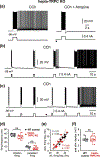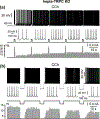TRPC channels are not required for graded persistent activity in entorhinal cortex neurons
- PMID: 31002217
- PMCID: PMC6791731
- DOI: 10.1002/hipo.23094
TRPC channels are not required for graded persistent activity in entorhinal cortex neurons
Abstract
Adaptive behavior requires the transient storage of information beyond the physical presence of external stimuli. This short-lasting form of memory involves sustained ("persistent") neuronal firing which may be generated by cell-autonomous biophysical properties of neurons or/and neural circuit dynamics. A number of studies from brain slices reports intrinsically generated persistent firing in cortical excitatory neurons following suprathreshold depolarization by intracellular current injection. In layer V (LV) neurons of the medial entorhinal cortex (mEC) persistent firing depends on the activation of cholinergic muscarinic receptors and is mediated by a calcium-activated nonselective cation current (ICAN ). The molecular identity of this conductance remains, however, unknown. Recently, it has been suggested that the underlying ion channels belong to the canonical transient receptor potential (TRPC) channel family and include heterotetramers of TRPC1/5, TRPC1/4, and/or TRPC1/4/5 channels. While this suggestion was based on pharmacological experiments and on effects of TRP-interacting peptides, an unambiguous proof based on TRPC channel-depleted animals is pending. Here, we used two different lines of TRPC channel knockout mice, either lacking TRPC1-, TRPC4-, and TRPC5-containing channels or lacking all seven members of the TRPC family. We report unchanged persistent activity in mEC LV neurons in these animals, ruling out that muscarinic-dependent persistent activity depends on TRPC channels.
Keywords: TRPC1/4/5 KO mice; hepta-TRPC KO mice; muscarinic; persistent firing.
© 2019 Wiley Periodicals, Inc.
Conflict of interest statement
Conflict of interest
The authors declare that they have no conflict of interest. The authors declare no competing financial interests.
Figures






Similar articles
-
Involvement of TRPC4 and 5 Channels in Persistent Firing in Hippocampal CA1 Pyramidal Cells.Cells. 2020 Feb 5;9(2):365. doi: 10.3390/cells9020365. Cells. 2020. PMID: 32033274 Free PMC article.
-
TRPC channels underlie cholinergic plateau potentials and persistent activity in entorhinal cortex.Hippocampus. 2011 Apr;21(4):386-97. doi: 10.1002/hipo.20755. Hippocampus. 2011. PMID: 20082292
-
Cholecystokinin facilitates neuronal excitability in the entorhinal cortex via activation of TRPC-like channels.J Neurophysiol. 2011 Sep;106(3):1515-24. doi: 10.1152/jn.00025.2011. Epub 2011 Jul 13. J Neurophysiol. 2011. PMID: 21753024 Free PMC article.
-
TRPC1 as a negative regulator for TRPC4 and TRPC5 channels.Pflugers Arch. 2019 Aug;471(8):1045-1053. doi: 10.1007/s00424-019-02289-w. Epub 2019 Jun 20. Pflugers Arch. 2019. PMID: 31222490 Review.
-
TRPC4 and TRPC5: receptor-operated Ca2+-permeable nonselective cation channels.Cell Calcium. 2003 May-Jun;33(5-6):441-50. doi: 10.1016/s0143-4160(03)00055-1. Cell Calcium. 2003. PMID: 12765689 Review.
Cited by
-
Potentiation of neuronal activity by tonic GluD1 current in brain slices.EMBO Rep. 2023 Jul 5;24(7):e56801. doi: 10.15252/embr.202356801. Epub 2023 May 8. EMBO Rep. 2023. PMID: 37154294 Free PMC article.
-
Transient Receptor Potential Canonical (TRPC) Channels: Then and Now.Cells. 2020 Aug 28;9(9):1983. doi: 10.3390/cells9091983. Cells. 2020. PMID: 32872338 Free PMC article. Review.
-
Cholinergic modulation shifts the response of CA1 pyramidal cells to depolarizing ramps via TRPM4 channels with potential implications for place field firing.Elife. 2023 Jul 5;12:e84387. doi: 10.7554/eLife.84387. Elife. 2023. PMID: 37404129 Free PMC article.
-
Involvement of TRPC4 and 5 Channels in Persistent Firing in Hippocampal CA1 Pyramidal Cells.Cells. 2020 Feb 5;9(2):365. doi: 10.3390/cells9020365. Cells. 2020. PMID: 32033274 Free PMC article.
-
Transient Receptor Potential Canonical Channels in Health and Disease: A 2020 Update.Cells. 2021 Feb 25;10(3):496. doi: 10.3390/cells10030496. Cells. 2021. PMID: 33668918 Free PMC article.
References
-
- Al-Yahya E, Hamel E, Kennedy TE, Alonso AA, & Egorov AV (2003). Persistent activity in entorhinal cortex neurons induced by muscarinic and metabotropic gluta-mate receptor activation and its dependence on TRP channels. Society for Neuroscience Abstract, 3775.
-
- Birnbaumer L (2015). From GTP and G proteins to TRPC channels: a personal account. Journal of Molecular Medicine (Berlin), 93(9), 941–553. - PubMed
-
- Bröker-Lai J, Kollewe A, Schindeldecker B, Pohle J, Nguyen Chi V, Mathar I, Guzman R, Schwarz Y, Lai A, Weißgerber P, Schwegler H, Dietrich A, Both M, Sprengel R, Draguhn A, Köhr G, Fakler B, Flockerzi V, Bruns D, & Freichel M (2017). Heteromeric channels formed by TRPC1, TRPC4 and TRPC5 define hippocam-pal synaptic transmission and working memory. EMBO Journal, 36(18), 2770–2789. - PMC - PubMed
Publication types
MeSH terms
Substances
Grants and funding
- SFB/Transregio 152, P07, P21/Deutsche Forschungsgemeinschaft/International
- Z01 ES101684/ImNIH/Intramural NIH HHS/United States
- SFB 1118, B02/Deutsche Forschungsgemeinschaft/International
- Z01-ES-101684/NIH Intramural Research Program/International
- FOR 2289, P02/Deutsche Forschungsgemeinschaft/International
LinkOut - more resources
Full Text Sources
Research Materials

